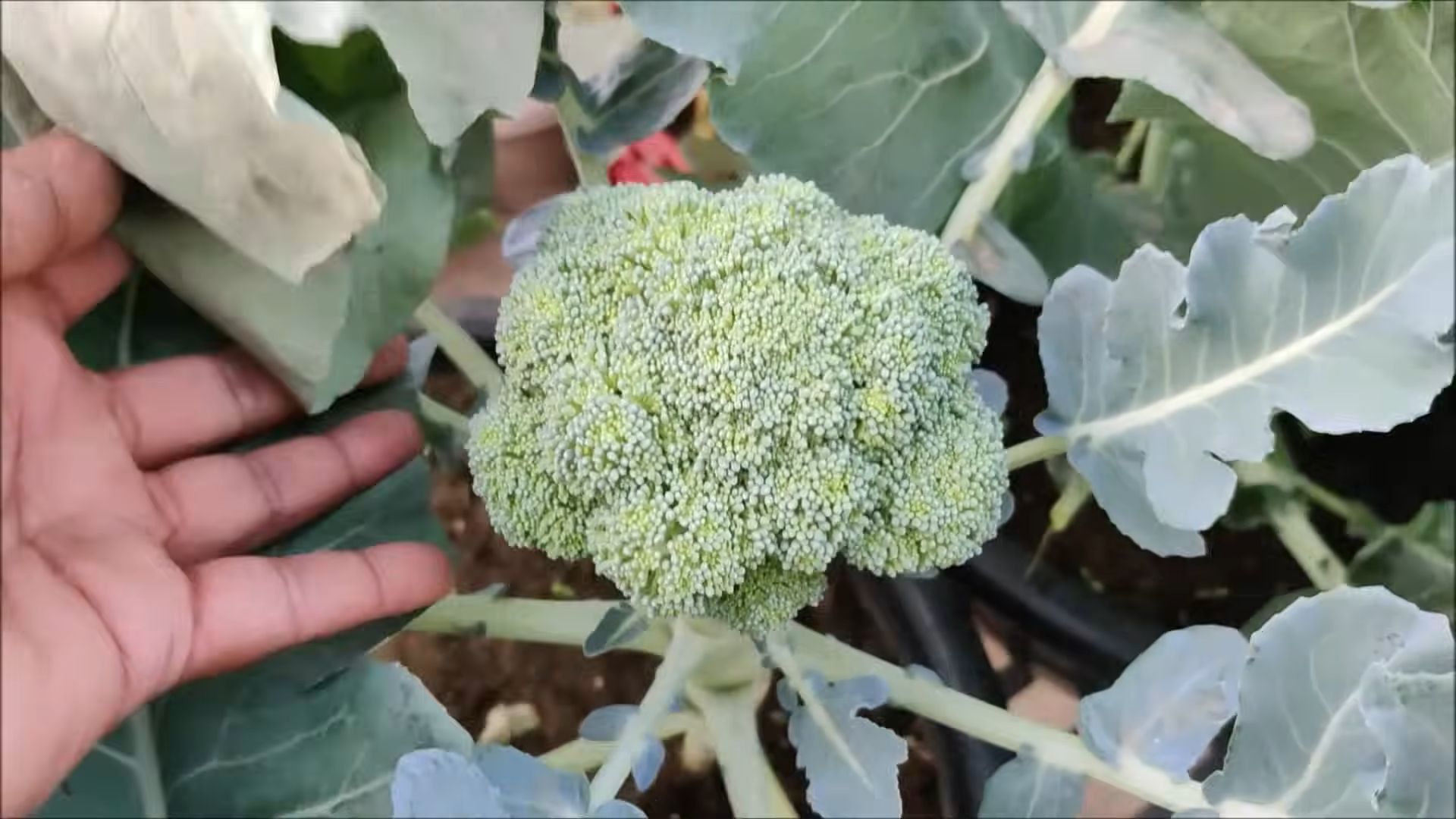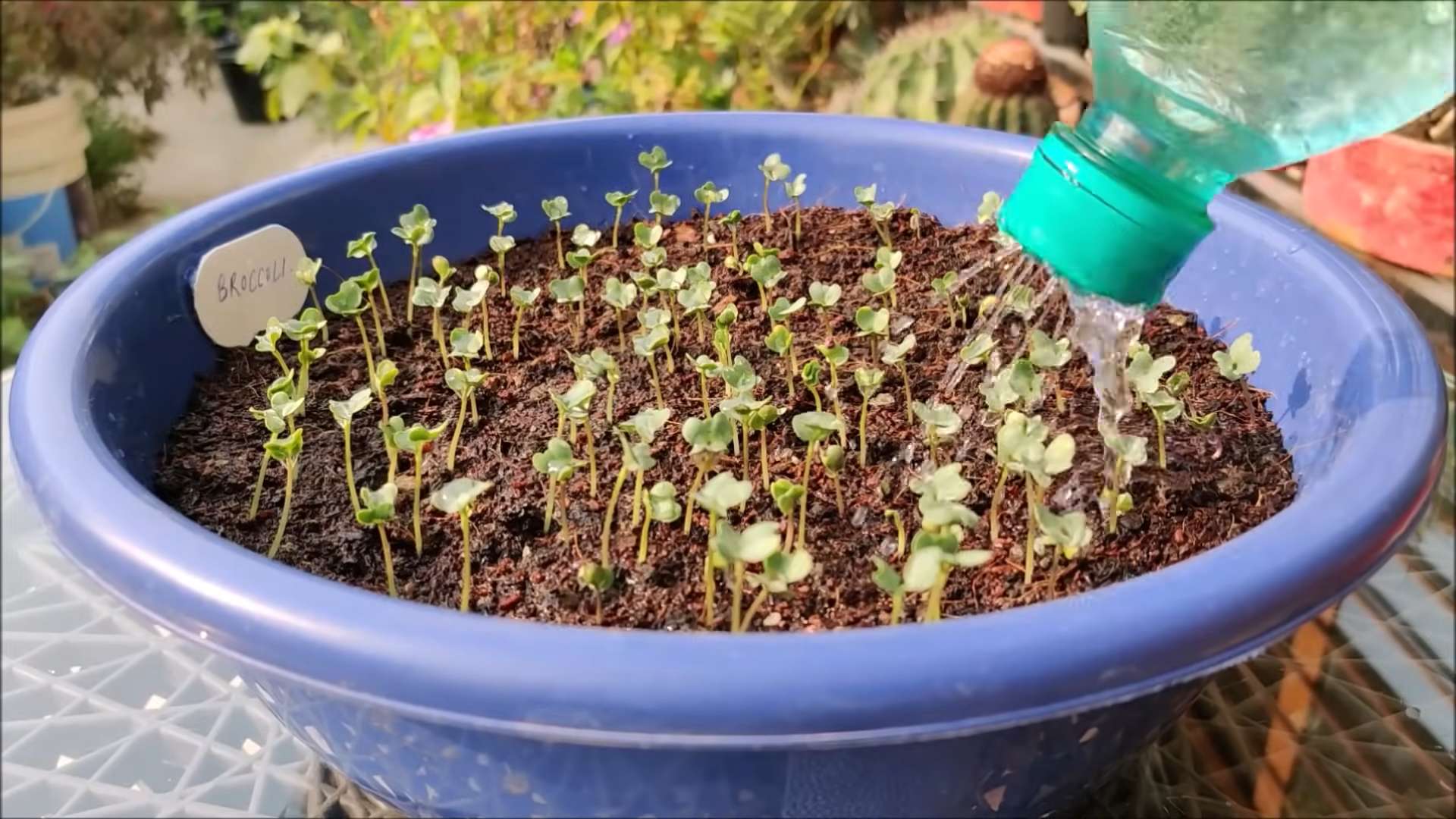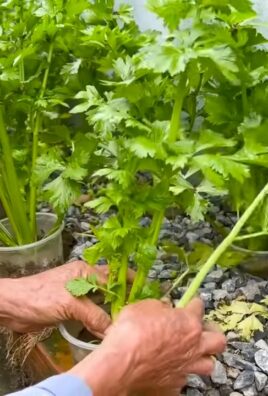Grow Broccoli At Home – sounds intimidating, right? But trust me, it’s easier than you think! Forget those pricey grocery store florets; imagine stepping into your backyard and harvesting your own fresh, crisp broccoli. For centuries, broccoli has been a staple in Mediterranean diets, prized for its nutritional value and unique flavor. From ancient Roman banquets to modern-day stir-fries, this humble vegetable has stood the test of time.
But why should you bother to grow broccoli at home? Well, for starters, homegrown broccoli tastes infinitely better than anything you can buy. Plus, you control exactly what goes into your garden, ensuring a pesticide-free, healthy harvest for you and your family. In this article, I’m going to share some simple DIY tricks and hacks that will transform even the most novice gardener into a broccoli-growing pro. We’ll cover everything from seed starting to pest control, so you can enjoy a bountiful broccoli harvest without breaking the bank. Get ready to get your hands dirty and discover the joy of growing your own delicious, nutritious broccoli!

Growing Broccoli at Home: A Beginner’s Guide
Hey there, fellow gardening enthusiasts! I’m so excited to share my experience with growing broccoli at home. It’s surprisingly rewarding, and nothing beats the taste of fresh, homegrown broccoli. Don’t be intimidated – even if you’re a complete beginner, you can absolutely do this! I’ll walk you through every step, from choosing the right variety to harvesting your delicious crop.
Choosing the Right Broccoli Variety
Before we even think about planting, let’s talk broccoli varieties. There are tons to choose from, and the best one for you will depend on your climate and preferences. Here are a few popular options:
* Calabrese: This is a classic, reliable variety that produces large, central heads. It’s a great choice for beginners.
* Waltham 29: Another popular choice, Waltham 29 is known for its cold hardiness, making it ideal for cooler climates.
* DiCicco: This variety produces smaller, more numerous side shoots after the main head is harvested, giving you a longer harvest period.
* Romanesco: If you’re feeling adventurous, try Romanesco! It’s a visually stunning variety with a unique, fractal-like head.
* Broccolini: Technically a hybrid of broccoli and Chinese kale, Broccolini offers tender stalks and small florets.
I personally love Calabrese for its large heads and ease of growing, but feel free to experiment and find your favorite!
Starting Your Broccoli Seeds
You have two options here: starting your seeds indoors or directly sowing them in your garden. I prefer starting indoors because it gives the seedlings a head start and protects them from pests and harsh weather.
Starting Seeds Indoors:
* Timing is Key: Start your seeds about 6-8 weeks before the last expected frost in your area. This will give them enough time to develop into strong seedlings before transplanting.
* Gather Your Supplies: You’ll need seed starting trays or small pots, seed starting mix (not regular potting soil!), broccoli seeds, and a spray bottle.
* Sowing the Seeds: Fill your trays or pots with seed starting mix. Make a small indentation (about ¼ inch deep) in the center of each cell or pot. Place 2-3 broccoli seeds in each indentation and cover them gently with more seed starting mix.
* Watering: Gently mist the soil with a spray bottle until it’s evenly moist. Avoid overwatering, which can lead to damping off (a fungal disease that kills seedlings).
* Providing Light: Broccoli seeds need light to germinate. Place your trays or pots under grow lights or in a sunny windowsill. If using a windowsill, rotate the trays regularly to prevent the seedlings from leaning towards the light.
* Maintaining Temperature: Broccoli seeds germinate best at temperatures between 65-75°F (18-24°C). Use a heat mat if necessary to maintain the optimal temperature.
* Thinning Seedlings: Once the seedlings emerge (usually within 5-10 days), thin them to one strong seedling per cell or pot. Snip off the weaker seedlings at the soil line with scissors.
* Hardening Off: Before transplanting your seedlings outdoors, you need to “harden them off.” This means gradually exposing them to outdoor conditions over a period of 7-10 days. Start by placing them in a sheltered spot outdoors for a few hours each day, gradually increasing the amount of time they spend outside.
Direct Sowing:
* Timing: Direct sow broccoli seeds 2-3 weeks before the last expected frost in spring, or in late summer for a fall harvest.
* Soil Preparation: Choose a sunny spot in your garden with well-drained soil. Amend the soil with compost or other organic matter to improve its fertility and drainage.
* Sowing the Seeds: Sow the seeds about ½ inch deep and 1-2 inches apart in rows.
* Watering: Keep the soil consistently moist until the seeds germinate.
* Thinning: Once the seedlings emerge, thin them to 18-24 inches apart.
Transplanting Your Broccoli Seedlings
Once your seedlings have developed several sets of true leaves and the weather has warmed up, it’s time to transplant them into your garden.
1. Prepare the Soil: Choose a sunny spot in your garden that gets at least 6 hours of sunlight per day. Broccoli needs rich, well-drained soil. Amend the soil with compost or well-rotted manure to improve its fertility. I like to add a slow-release organic fertilizer at this stage as well.
2. Dig the Holes: Dig holes that are slightly larger than the root balls of your seedlings. Space the holes 18-24 inches apart. This spacing allows the broccoli plants to have enough room to grow and develop large heads.
3. Carefully Remove the Seedlings: Gently remove the seedlings from their trays or pots. Be careful not to damage the roots. If the roots are tightly bound, gently loosen them with your fingers.
4. Plant the Seedlings: Place the seedlings in the holes and backfill with soil. Make sure the top of the root ball is level with the surrounding soil.
5. Water Thoroughly: Water the seedlings thoroughly after planting. This will help them settle in and establish their roots.
6. Mulch: Apply a layer of mulch around the plants to help retain moisture, suppress weeds, and regulate soil temperature. I like to use straw or shredded leaves.
7. Protect from Pests: Broccoli is susceptible to several pests, including cabbage worms, aphids, and flea beetles. Consider using row covers to protect your plants from these pests. You can also use organic pest control methods, such as insecticidal soap or neem oil.
Caring for Your Broccoli Plants
Once your broccoli plants are in the ground, they’ll need regular care to thrive.
1. Watering: Broccoli needs consistent moisture, especially during head formation. Water deeply and regularly, especially during dry spells. Aim for about 1-1.5 inches of water per week.
2. Fertilizing: Broccoli is a heavy feeder, so it needs regular fertilization. Side-dress your plants with a balanced organic fertilizer every 3-4 weeks. You can also use a liquid fertilizer, such as fish emulsion or seaweed extract.
3. Weeding: Keep the area around your broccoli plants free of weeds. Weeds compete with broccoli for nutrients and water.
4. Pest Control: Regularly inspect your plants for pests. If you find any, take action immediately. Handpicking pests, using insecticidal soap, or applying neem oil are all effective methods.
5. Supporting the Plants: As the broccoli heads grow larger, they may need support. You can use stakes or tomato cages to prevent the plants from falling over.
Harvesting Your Broccoli
Harvesting broccoli at the right time is crucial for getting the best flavor and texture.
1. Timing: Harvest your broccoli when the heads are firm, tight, and dark green. The florets should be tightly closed. If the florets start to open and turn yellow, it’s time to harvest immediately.
2. Cutting the Head: Use a sharp knife to cut the main head from the plant. Cut the stem at an angle, leaving about 6 inches of stem attached to the head.
3. Encouraging Side Shoots: After harvesting the main head, the plant will often produce side shoots. These smaller heads can be harvested as they mature. This will extend your harvest period.
4. Storage: Store your harvested broccoli in the refrigerator. It will keep for about a week.
Troubleshooting Common Broccoli Problems
Even with the best care, you may encounter some problems when growing broccoli. Here are a few common issues and how to address them:
* Cabbage Worms: These green caterpillars can quickly devour your broccoli plants. Handpick them off the plants or use Bacillus thuringiensis (Bt), a natural insecticide.
* Aphids: These tiny insects suck the sap from plants, causing them to weaken and distort. Spray aphids with insecticidal soap or neem oil.
* Flea Beetles: These small, jumping beetles can create tiny holes in the leaves of your broccoli plants. Use row covers to protect your plants or spray them with neem oil.
* Clubroot: This fungal disease causes the roots of broccoli plants to swell and distort. Prevent clubroot by improving soil drainage and rotating your crops.
* Bolting: Bolting occurs when broccoli plants flower prematurely. This can be caused by hot weather or stress. Prevent bolting by providing adequate water and shade during hot weather.
Enjoying Your Homegrown Broccoli
Congratulations! You’ve successfully grown your own broccoli. Now it’s time to enjoy the fruits (or rather, vegetables) of your labor. Here are a few ideas:
* Steamed Broccoli: A classic and simple way to

Conclusion
So, there you have it! Growing broccoli at home is not only achievable, but it’s also incredibly rewarding. Forget those bland, overpriced heads from the supermarket. Imagine stepping into your garden and harvesting crisp, vibrant, and intensely flavorful broccoli whenever you crave it. This DIY approach puts you in complete control, from seed to table, ensuring you’re enjoying the freshest, most nutritious broccoli possible.
Why is this a must-try? Because it’s about more than just saving money (though that’s a definite perk!). It’s about connecting with your food, understanding its journey, and experiencing the satisfaction of nurturing something from a tiny seed into a bountiful harvest. Plus, homegrown broccoli simply tastes better. The flavor is more pronounced, the texture is crisper, and you know exactly what went into growing it – no mystery pesticides or long-distance transportation.
But the best part? You can customize your broccoli growing experience! Want to try different varieties? Go for it! Experiment with Romanesco broccoli for its stunning fractal patterns, or try sprouting broccoli for a continuous harvest of tender shoots. You can also adjust your growing methods to suit your climate and space. Container gardening is perfect for smaller spaces, while raised beds offer better drainage and soil control.
Don’t be intimidated if you’re a beginner gardener. Growing broccoli at home is surprisingly straightforward with a little planning and attention. The steps outlined in this guide are designed to be easy to follow, even for those with limited experience. And remember, even if you encounter a few challenges along the way, the learning process is part of the fun.
We wholeheartedly encourage you to give this DIY trick a try. Imagine the pride you’ll feel when you serve a meal featuring broccoli you grew yourself. It’s a conversation starter, a testament to your resourcefulness, and a delicious way to nourish yourself and your loved ones.
Once you’ve embarked on your broccoli-growing adventure, we’d love to hear about your experience! Share your tips, successes, and even your challenges in the comments below. Let’s build a community of home broccoli growers and learn from each other. What variety did you choose? What growing method worked best for you? What delicious recipes did you create with your homegrown harvest? Your insights could inspire others to take the plunge and discover the joys of growing their own broccoli. So, get your hands dirty, embrace the process, and enjoy the incredible rewards of growing broccoli at home!
Frequently Asked Questions (FAQ)
1. What is the best time of year to start growing broccoli?
The best time to start growing broccoli depends on your climate. Broccoli is a cool-season crop, meaning it thrives in temperatures between 60°F and 70°F (15°C and 21°C). In areas with mild winters, you can plant broccoli in the fall for a winter or early spring harvest. In colder climates, start seeds indoors 6-8 weeks before the last expected frost and transplant them outdoors in the spring after the danger of frost has passed. You can also plant a second crop in late summer for a fall harvest. Pay attention to your local weather patterns and adjust your planting schedule accordingly.
2. What kind of soil does broccoli need?
Broccoli prefers well-drained, fertile soil that is rich in organic matter. The ideal soil pH is between 6.0 and 7.0. Before planting, amend your soil with compost or well-rotted manure to improve its fertility and drainage. Broccoli is a heavy feeder, so it benefits from regular fertilization. You can use a balanced fertilizer or a fertilizer specifically formulated for vegetables. Consider getting a soil test to determine the specific nutrient needs of your soil.
3. How much sunlight does broccoli need?
Broccoli requires at least 6 hours of direct sunlight per day to thrive. Choose a planting location that receives plenty of sunlight throughout the day. If you live in a particularly hot climate, some afternoon shade can be beneficial to prevent the broccoli from bolting (going to seed prematurely).
4. How often should I water my broccoli plants?
Broccoli needs consistent moisture to grow properly. Water deeply and regularly, especially during dry periods. Aim to keep the soil consistently moist but not waterlogged. Mulching around your broccoli plants can help to retain moisture and suppress weeds. Check the soil moisture regularly by sticking your finger into the soil. If the top inch feels dry, it’s time to water.
5. What are some common pests and diseases that affect broccoli?
Broccoli is susceptible to several pests and diseases, including cabbage worms, aphids, flea beetles, and clubroot. Regularly inspect your plants for signs of pests or diseases. You can control cabbage worms by handpicking them off the plants or using Bacillus thuringiensis (Bt), a natural insecticide. Aphids can be controlled with insecticidal soap or a strong spray of water. Flea beetles can be deterred by using row covers. Clubroot is a soilborne disease that can be prevented by practicing crop rotation and maintaining a soil pH above 7.0.
6. How do I know when my broccoli is ready to harvest?
Broccoli is ready to harvest when the central head is firm and the florets are tightly closed. The size of the head will vary depending on the variety, but generally, it should be about 4-7 inches in diameter. Use a sharp knife to cut the head from the plant, leaving a few inches of stem. After harvesting the central head, the plant will often produce side shoots, which can be harvested as well.
7. Can I grow broccoli in containers?
Yes, you can grow broccoli in containers, but you’ll need to choose a large container that is at least 12 inches in diameter and 12 inches deep. Use a high-quality potting mix and ensure that the container has good drainage. Container-grown broccoli may require more frequent watering and fertilization than broccoli grown in the ground. Choose a compact broccoli variety that is well-suited for container gardening.
8. What are some different varieties of broccoli I can grow?
There are many different varieties of broccoli to choose from, each with its own unique characteristics. Some popular varieties include ‘Waltham 29’, ‘Packman’, ‘Green Magic’, ‘DiCicco’, and ‘Romanesco’. ‘Waltham 29’ is a reliable heirloom variety that produces large, uniform heads. ‘Packman’ is a fast-maturing variety that is well-suited for short growing seasons. ‘Green Magic’ is a hybrid variety that is known for its heat tolerance. ‘DiCicco’ is an Italian heirloom variety that produces numerous side shoots after the central head is harvested. ‘Romanesco’ is a unique variety with a stunning fractal pattern.
9. How can I prevent my broccoli from bolting?
Bolting, or premature flowering, can occur when broccoli is exposed to stress, such as high temperatures or drought. To prevent bolting, choose heat-tolerant varieties, provide consistent moisture, and protect your plants from extreme temperatures. Mulching around your broccoli plants can help to keep the soil cool and moist. If you live in a hot climate, consider providing some afternoon shade for your broccoli plants.
10. What are some ways to use homegrown broccoli?
Homegrown broccoli can be used in a variety of dishes. It can be steamed, roasted, stir-fried, or eaten raw. Broccoli is a great addition to salads, soups, and casseroles. You can also use it to make broccoli cheese soup, broccoli slaw, or broccoli pesto. The possibilities are endless! Enjoy the fresh, delicious flavor of your homegrown broccoli in your favorite recipes.





Leave a Comment